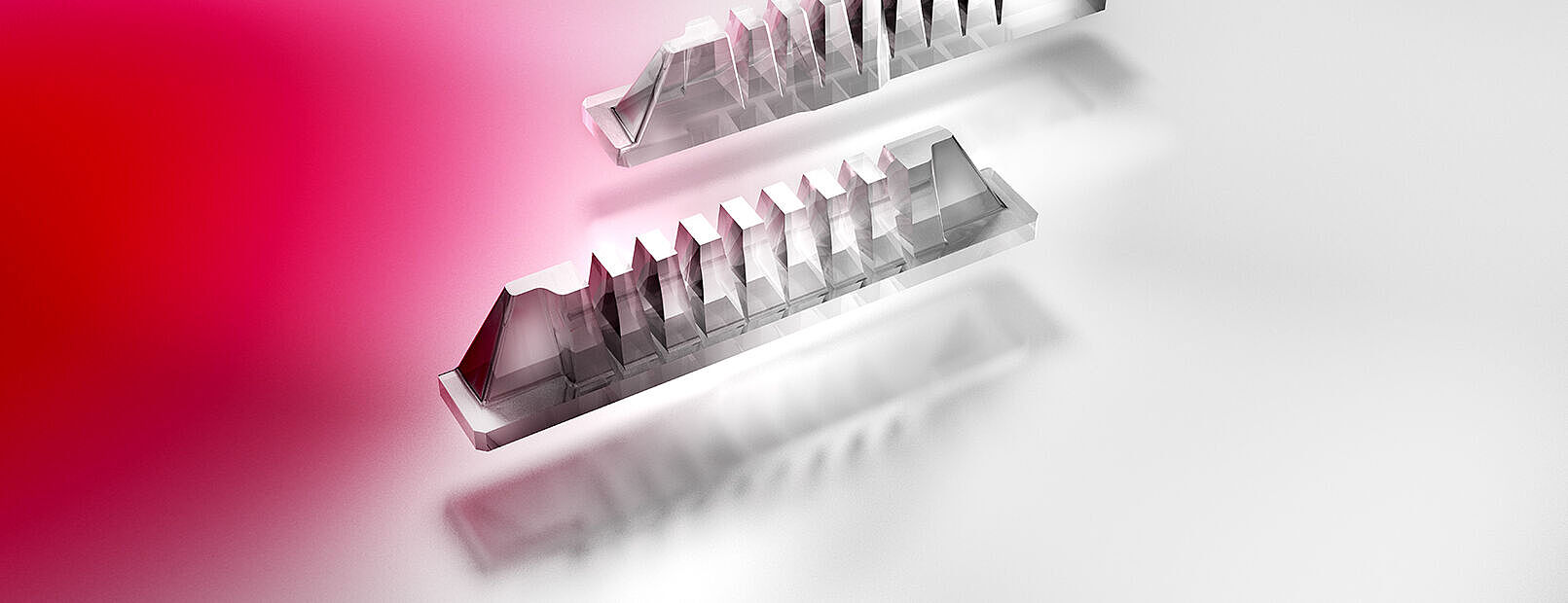
During the past years, glass has taken a back seat as optics material for automotive headlamps, mainly because of its higher density compared to polymer based optics. However, newer systems, in particular those with adaptive driving beam (ADB) functionalities, require small sized optics which are able to handle the high optical power densities of new LED and laser light sources. Coupled with new pressing technologies and surface micro structuring, complex optics made of glass are now returning as the optimal solution to withstand the harsher system conditions.
The proprietary glass injection molding technology (GIMT) allows for high length-to-width aspect ratios, which are especially useful for demanding primary optics like light guide arrays for ADB functionalities.
In the figure above such a primary optics array is shown. Each frustum of a cone represents one addressable illumination area (“pixel”) of the final light distribution. A large part of such optics is equipped with flat entrance surfaces, which then can be placed almost in touch to flat light emitters. This guarantees maximum light capture. The angled lateral surfaces are narrowing the angular light distribution of the LED. Angle and length are responsible for light spread and spatial separability between light of neighboring pixels in the final distribution. The frustum’s footprint is imaged onto the road and hence determines the illuminated area. Therefore, the distance between two neighboring pixels should be as small as possible in order to not produce any dark gaps in the light field. The minimum distance is defined by the radii at the intercepts formed by two tapered surfaces. They are needed to ensure a sufficient long tool life during glass hot forming and, consequently, to keep product cost low. Possible arising shadows can be dissolved by lens defocusing, implementation of diffusing surface structures or geometry adjustments.
The figure shows an example that combines multiple light functionalities in only one piece, reducing the number of total system components and increasing performance.
We use cookies. Some of them are necessary to make the website usable. Others help us display information that is relevant and engaging to you. As data protection is important to us, we ask you to decide on the scope of use. You can either accept all cookies or choose your individual settings. You can withdraw your consent at any time by reopening this tool. Thanks and enjoy our website!
This is an overview of all cookies used on this website. Please make your individual settings. You can adapt them at any time by using the "Cookie settings" link in the footer of this website.
These cookies are essential to the operation of the website, e.g. by saving your cookie settings.
| Name | alto. Cookie |
|---|---|
| Provider | Provider |
| Purpose | Saves the visitor's settings |
| Identifier | alto-cookie |
| Validity | 1 year |
Tools collecting usage data anonymoulsy, giving insights into how to improve our services for you.
| Accept | |
|---|---|
| Name | Google Analytics |
| Provider | Google LLC |
| Purpose | Google cookie for website analyses. Creates statistical data on website usage. |
| Privacy | https://policies.google.com/privacy |
| Identifier | _ga,_gat,_gid |
| Validity | 2 years |
Tools enhancing the browsing exerience, e.g. maps or videos.
| Accept | |
|---|---|
| Name | YouTube |
| Provider | YouTube, LLC |
| Purpose | Used to unlock Youtube contents. |
| Privacy | https://policies.google.com/privacy |
| Identifier | yt-remote-fast-check-period, yt-remote-session-app, yt-remote-session-name |
| Validity | Session |
| Accept | |
|---|---|
| Name | Google Maps |
| Provider | Google LLC |
| Purpose | Used to unlock Google Maps contents. |
| Privacy | https://policies.google.com/privacy |
| Identifier | NID |
| Validity | 2 Years |
| Accept | |
|---|---|
| Name | Vimeo |
| Provider | Vimeo, LLC |
| Purpose | Used to unlock Vimeo contents. |
| Privacy | https://vimeo.com/privacy |
| Identifier | vuid |
| Validity | 2 Years |